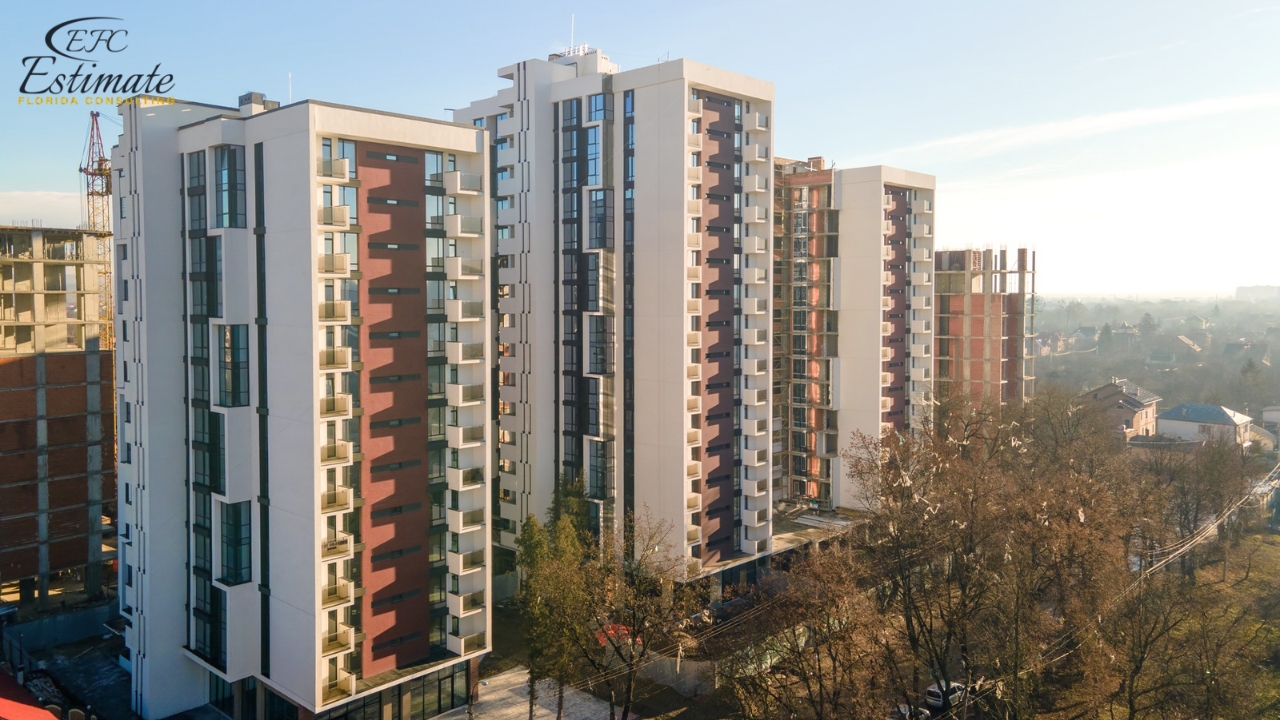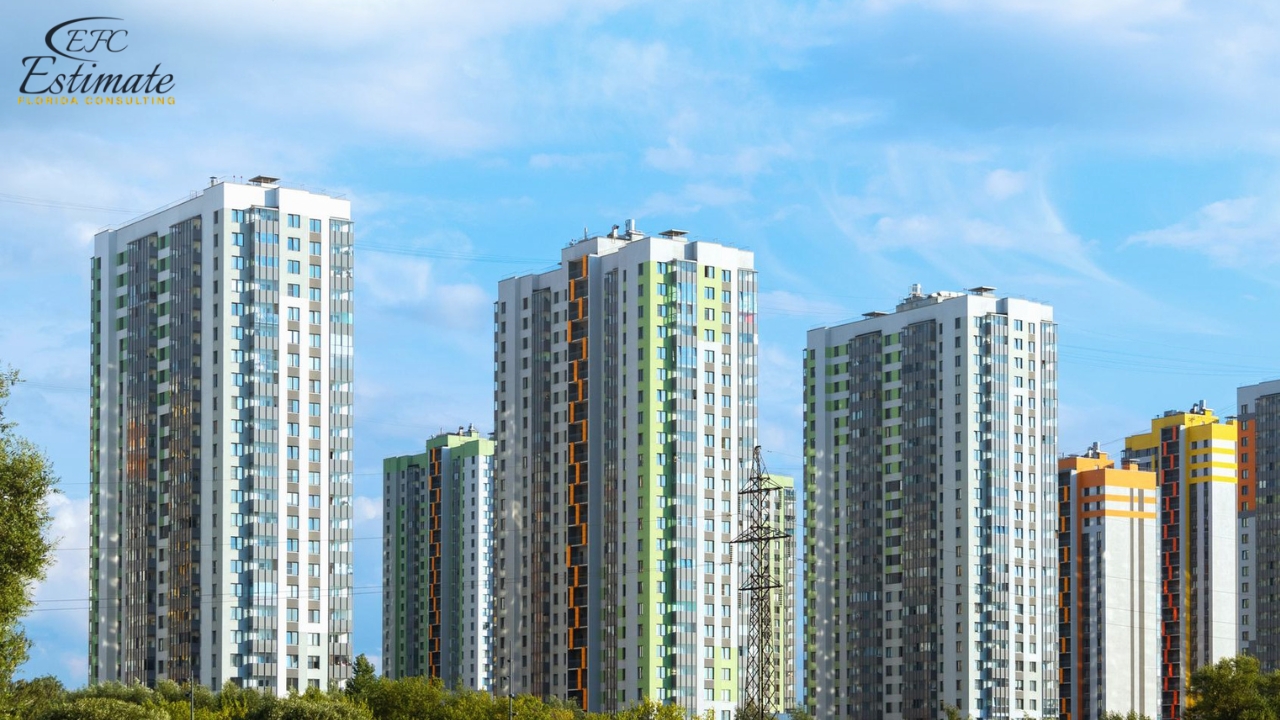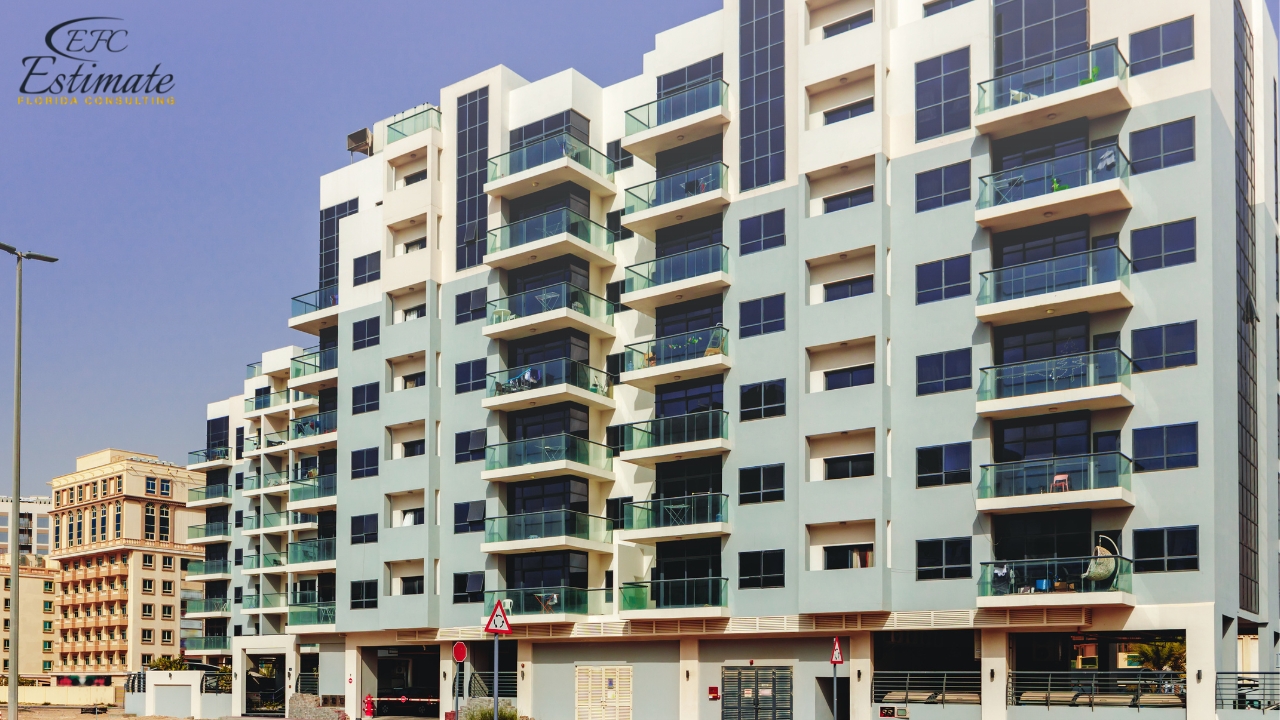- Homepage
- Construction In miami
Apartments Construction in Miami
Leading provider of apartments construction services.
Miami’s skyline is constantly evolving, and your apartment project deserves to stand out. Whether you’re constructing a luxury high-rise or a multi-family complex, precise cost estimation is the key to success. At Estimate Florida Consulting, we provide accurate, detailed, and fast construction estimates tailored to Miami’s competitive market.
From material and labor costs to insulation and painting, we break down every expense so you can stay on budget and maximize profitability. Our expert insights help you secure financing, negotiate contracts, and avoid costly surprises.

Average Cost of Apartment Construction in Miami
The cost of constructing an apartment complex in Miami depends on various factors, including size, design, materials, and labor. On average:
Construction Type | Cost per Square Foot |
Low-end construction | $195 – $260 |
Mid-range construction | $260 – $390 |
High-end/luxury construction | $390 – $650+ |
For example, a 50,000-square-foot apartment complex could cost between $9.75 million and $32.5 million, depending on the level of finishes, amenities, and additional structural requirements.
Key Factors Affecting Apartment Construction Costs
Location & Land Costs
Miami’s real estate prices vary significantly based on the neighborhood. Areas like Brickell and South Beach tend to have higher land prices than suburban regions. Land costs can account for 20-30% of the total project cost, and competition for prime locations can further drive up expenses. Additionally, factors such as proximity to commercial hubs, accessibility to public transportation, and local economic growth impact land prices. Developers must also consider soil conditions and potential environmental remediation costs, which can add to the land acquisition budget.
90% More Chances to Win Apartment Construction Bids with Our Estimate!
Building Size & Number of Units
Larger buildings with more units may reduce the cost per unit but increase total project expenses. A high-rise apartment complex costs more per square foot than a low-rise building due to additional structural and zoning requirements. High-density developments may also require enhanced fire safety measures and elevator installations, further increasing costs. Moreover, the inclusion of multiple floor plans, unit customization options, and mixed-use spaces (such as retail areas on the ground floor) can influence the final construction budget. In some cases, economies of scale can be achieved, but additional expenses such as reinforced foundations, structural supports, and advanced HVAC systems may offset cost savings.
Materials & Labor
Material costs fluctuate based on market demand. Miami’s coastal environment also demands durable materials, such as hurricane-resistant windows and corrosion-resistant steel, which increase costs. Additionally, construction materials such as reinforced concrete, impact-resistant glass, and high-performance insulation contribute to both safety and long-term sustainability. Skilled labor shortages can further drive up construction expenses, with wages in the construction industry rising due to demand. Contractors must also account for labor productivity, training programs, and potential delays caused by workforce shortages. The use of prefabricated or modular construction methods can sometimes help control costs and improve efficiency.

Permits & Regulatory Compliance
Miami has strict building codes, including hurricane-resistant construction requirements. Permitting fees, environmental impact studies, and zoning regulations contribute to the overall cost. Developers must navigate complex approval processes, including site plan reviews, environmental impact assessments, and historical preservation requirements in certain areas. Delays in securing permits can also increase project expenses and push back construction timelines. Compliance with ADA (Americans with Disabilities Act) standards, green building certifications, and energy efficiency regulations may further influence construction budgets. Proper planning and working with experienced consultants can help mitigate potential compliance risks and unexpected expenses.
Design & Amenities
Modern apartments with high-end finishes, smart home features, and resort-style amenities (pools, gyms, rooftop terraces) will significantly increase construction costs. Developers aiming for premium renters often invest heavily in features like high-speed internet, security systems, and energy-efficient appliances. The choice of interior finishes, such as hardwood flooring, quartz countertops, and designer fixtures, can further impact project costs. Additionally, common areas like coworking spaces, entertainment lounges, pet-friendly amenities, and concierge services add value but also increase the overall budget. Thoughtful architectural design, sustainable building techniques, and efficient space utilization can help balance costs while enhancing tenant satisfaction.
Infrastructure & Utilities
Connecting the building to water, electricity, and sewage systems adds to the overall cost. For larger apartment complexes, additional parking structures, stormwater management systems, or underground utilities may be necessary, adding substantial expenses to the budget. Developers must also consider energy-efficient infrastructure, including solar panels, EV charging stations, and smart water management systems to comply with evolving sustainability standards. Road improvements, pedestrian walkways, and landscaping are additional factors influencing infrastructure costs. In urban settings, retrofitting existing infrastructure or integrating renewable energy solutions may require additional planning and investment.
Cost Breakdown of Apartment Construction
Here’s a rough breakdown of the estimated costs per category:
Category | Cost per Square Foot |
Land Acquisition | 20-30% of total cost |
Site Preparation & Foundation | $13 – $32.50 |
Framing & Structural Work | $65 – $130 |
HVAC, Electrical & Plumbing | $39 – $97.50 |
Interior Finishes | $65 – $195 |
Permits & Miscellaneous Fees | $6.50 – $26 |
Get 5 New Projects in the Next 7 Days With Our System
Types of Apartment Buildings in Miami
Miami’s diverse real estate market features a wide range of apartment buildings catering to various lifestyles and budgets. The city’s architectural landscape is shaped by its coastal location, population density, and demand for both luxury and affordable housing. Here are the main types of apartment buildings found in Miami:
Low-Rise Apartments
Low-rise apartments are typically between one and three stories tall, making them a common choice in suburban and residential neighborhoods. These buildings are more affordable to construct due to their simpler design and reduced need for structural reinforcements. Many low-rise apartments feature garden-style layouts with open courtyards, green spaces, and surface-level parking. They often attract families, students, and young professionals looking for a quieter living environment away from the hustle and bustle of downtown Miami.
Mid-Rise Apartments
Mid-rise apartments range from four to ten stories and offer a balance between affordability and amenities. These buildings are commonly found in urban neighborhoods, such as Coral Gables and Brickell, where land is more expensive but high-rise developments are not always feasible. Mid-rise apartments typically include modern design elements, such as elevators, parking garages, and enhanced security features. Some buildings also offer shared amenities like fitness centers, lounges, and rooftop terraces, making them attractive to young professionals and small families.
High-Rise Apartments
High-rise apartments in Miami exceed ten stories and are often located in prime locations, such as Downtown Miami, Brickell, and Edgewater. These buildings require advanced engineering solutions, reinforced structures, and high-quality materials to withstand hurricanes and other environmental factors. High-rise apartments often cater to luxury renters and buyers, offering premium amenities like rooftop pools, concierge services, state-of-the-art fitness centers, and smart home technology. Many of these buildings provide breathtaking views of the Miami skyline, Biscayne Bay, or the Atlantic Ocean, making them highly desirable among professionals, investors, and high-net-worth individuals.

Luxury Condominiums
While similar in height to high-rise apartments, luxury condominiums cater to an exclusive clientele. These buildings offer premium features such as private elevators, high-end finishes, expansive balconies, and access to world-class amenities like spas, private beach clubs, and fine dining establishments. Areas like Sunny Isles Beach, Bal Harbour, and Fisher Island are known for their high-end condominiums, attracting international buyers and affluent residents.
Mixed-Use Apartment Buildings
Mixed-use apartment buildings combine residential, commercial, and retail spaces, creating vibrant communities where residents can live, work, and shop in one location. These developments are increasingly popular in Miami’s urban areas, such as Wynwood and Midtown, where space is limited, and walkability is a priority. Ground floors often house restaurants, cafes, co-working spaces, and boutiques, while the upper floors feature residential units. This type of development appeals to young professionals, entrepreneurs, and creatives who enjoy an active and convenient lifestyle.
Senior Living Apartments
Designed specifically for older adults, senior living apartments in Miami offer features such as step-free access, medical assistance, community activities, and wellness programs. These buildings range from low-rise to high-rise structures and provide different levels of care, from independent living to assisted living and memory care. Many senior apartments are located in quieter, well-connected areas with easy access to healthcare facilities, shopping centers, and public transportation.
3D Rendering Cost for Apartment Buildings in Miami
The cost of 3D rendering for apartment buildings in Miami varies based on several factors, including project complexity, the number of images required, and the level of detail desired. Generally, 3D rendering services can range from $400 for smaller projects to over $10,000 for high-end.
We Provide 3D Rendering Services!
For Apartments Construction and Other Projects
Turnaround time is 1-2 days.
Win More Projects With Us
Sustainable & Energy-Efficient Apartment Construction
Green Building Materials
Using sustainable materials like recycled steel, bamboo flooring, and eco-friendly insulation can lower long-term operational costs. Many developers aim for LEED certification to improve energy efficiency and attract environmentally-conscious tenants. These materials not only reduce environmental impact but also enhance durability and indoor air quality. Additionally, using reclaimed wood, low-VOC (volatile organic compound) paints, and non-toxic adhesives can contribute to a healthier living environment for residents. Innovations in green concrete and biodegradable construction materials further support sustainability efforts while maintaining structural integrity.
Energy-Efficient Systems
Installing solar panels, LED lighting, and smart HVAC systems helps reduce energy consumption. Smart home technology, such as automated thermostats and energy monitoring systems, can further enhance efficiency. High-performance insulation, energy-efficient windows, and advanced building envelope designs help regulate indoor temperatures and reduce reliance on heating and cooling systems. Additionally, integrating battery storage solutions with renewable energy sources can help optimize electricity use and provide backup power during outages. Motion sensors, daylight harvesting systems, and demand-controlled ventilation contribute to overall energy savings and environmental responsibility.
Water Conservation
Miami’s water regulations encourage builders to use low-flow fixtures, rainwater harvesting systems, and drought-resistant landscaping to reduce water consumption and minimize environmental impact. Smart irrigation systems that adjust watering schedules based on weather conditions can further conserve water resources. Developers are increasingly incorporating greywater recycling systems, which reuse water from sinks and showers for landscaping or toilet flushing. Permeable pavement solutions help manage stormwater runoff, preventing urban flooding and reducing strain on municipal drainage systems. Water-efficient plumbing design and leak detection technology also play a crucial role in sustainability and cost savings over time.
How Estimate Florida Consulting Can Help?
At Estimate Florida Consulting, we specialize in providing accurate construction cost estimates, feasibility studies, and budgeting assistance for apartment projects in Miami. Our expert team ensures that your project stays on budget and meets all regulatory requirements. We help you avoid unexpected expenses and streamline your development process.
Role of Professionals for Apartment Building Construction in Miami
- Contractors: Manage the entire apartment construction project, ensuring high-quality work, overseeing materials, labor, and schedules while complying with Miami’s building codes and safety regulations. Hiring experienced contractors ensures smooth project execution.
- Subcontractors: Handle specialized tasks such as electrical wiring, plumbing, HVAC systems, and structural reinforcements to enhance durability and efficiency. Skilled subcontractors are essential for high-quality construction.
- Architects: Design modern, functional, and energy-efficient apartment layouts that maximize space, comply with Florida’s building regulations, and attract tenants. Professional architects help create visually appealing and practical designs.
- Engineers: Ensure the structural stability, safety, and efficiency of apartment buildings by overseeing mechanical, electrical, and civil components. Expert engineers play a crucial role in constructing sustainable and resilient apartments in Miami.
Conclusion
Miami’s apartment construction market presents exciting opportunities, but it also comes with significant financial and regulatory challenges. Understanding cost factors such as land prices, materials, labor, and amenities is crucial to ensuring a successful project. By considering sustainable building practices and energy-efficient solutions, developers can enhance long-term profitability while meeting Miami’s stringent building codes.
For a smooth construction process, partnering with experts like Estimate Florida Consulting can make all the difference. Our team provides precise cost estimates and strategic guidance to keep your project on track. Call us today at 561-530-2845 for a free estimate and expert advice on your apartment development in Miami!
Question Answer
Frequently Asked Question
The cost varies based on construction type, materials, and location. On average:
- Low-end construction: $195 - $260 per square foot
- Mid-range construction: $260 - $390 per square foot
- High-end/luxury construction: $390 - $650+ per square foot
A 50,000-square-foot apartment complex could cost between $9.75 million and $32.5 million, depending on finishes, amenities, and structural requirements.
Key cost factors include:
- Location & Land Costs – Prime areas like Brickell and South Beach are more expensive.
- Building Size & Number of Units – Larger projects may reduce per-unit costs but increase total expenses.
- Materials & Labor – Durable, hurricane-resistant materials and skilled labor raise costs.
- Permits & Compliance – Strict Miami building codes add to expenses.
- Amenities & Design – Luxury features like pools, smart tech, and security systems increase costs.
- Low-Rise (1-3 stories) – More affordable, common in suburban areas.
- Mid-Rise (4-10 stories) – Balance between cost and amenities, found in urban areas.
- High-Rise (10+ stories) – Expensive to build, often include luxury features.
Timelines vary by project size and complexity:
- Small low-rise apartments – 12-18 months
- Mid-rise buildings – 18-30 months
- High-rise developments – 30+ months
Permitting and site preparation can add extra time.
- Lower utility costs – Solar panels, LED lighting, and smart HVAC systems reduce expenses.
- Sustainability – Green materials like recycled steel and bamboo flooring improve efficiency.
- Water conservation – Low-flow fixtures and rainwater harvesting meet Miami’s regulations.
Miami has strict hurricane-resistant building codes and zoning laws. Developers must obtain:
- Building permits
- Environmental impact approvals
- Structural safety certifications
Failure to comply can lead to costly delays and fines.
Construction Professionals For Your Project?
- Electrical
- Plumbing
- Masonry
- Roofing
- Painting
- More

